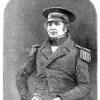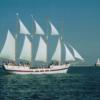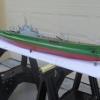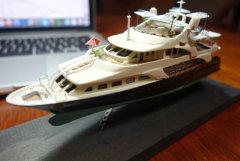MORE HANDBOOKS ARE ON THEIR WAY! We will let you know when they get here.
×
-
Posts
410 -
Joined
-
Last visited
Reputation Activity
-
 Erebus and Terror reacted to druxey in Greenwich Hospital barge of 1832 by druxey - FINISHED - 1:48 scale
Erebus and Terror reacted to druxey in Greenwich Hospital barge of 1832 by druxey - FINISHED - 1:48 scale
Horsehair filled...or straw.
Finally have solved the gilding issue. After some experimentation I am using Golden artist color brand acrylic tube paint. It is called Iridescent Gold (fine). The particles are much finer than in other brands I've tried. Photographing this is difficult, but the photos give some idea of the result. Keen eyes will notice I've repainted the blue strake a dark green-black, referred to as merde d'oie. (If you don't know French, look this up!)
-
 Erebus and Terror reacted to druxey in Greenwich Hospital barge of 1832 by druxey - FINISHED - 1:48 scale
Erebus and Terror reacted to druxey in Greenwich Hospital barge of 1832 by druxey - FINISHED - 1:48 scale
And here are the seat cushions. They were carved from some pear stock 3" thick. The piping along the edges was some fine line left over from another model. It was applied using acrylic matt medium. Had I used white glue, it would have dissolved when I painted the cushions with acrylic paint. I may deepen their color.
Experiments with 'gold' are beginning to yield promising results. More soon.
-
 Erebus and Terror reacted to druxey in Greenwich Hospital barge of 1832 by druxey - FINISHED - 1:48 scale
Erebus and Terror reacted to druxey in Greenwich Hospital barge of 1832 by druxey - FINISHED - 1:48 scale
Some progress while I wait for various 'gilding' materials to arrive. The coach benches are made and installed. For the moment the forward and aft coach bulkheads are temporarily slotted into position and still removable.
The plan of the coach indicates a locker lid aft. The benches were cushioned for the benefit of the Lord Commissioners' backsides, so these are next. I'll model them based on the ones seen in Prince Frederick's barge
-
 Erebus and Terror reacted to EdT in Young America 1853 by EdT - FINISHED - extreme clipper
Erebus and Terror reacted to EdT in Young America 1853 by EdT - FINISHED - extreme clipper
Young America - extreme clipper 1853
Part 155 – Channel Deadeyes 1
The next major task on the model is to fit out the channels with deadeyes, chains, bindings and backing (preventer) plates. You may notice in these posts that some of the terminology diverges from what most of us are used to – namely British RN usage. I am trying very hard to use 19th Century American terms, gleaned mostly from texts from the period.
So, the first step is to make the 16” chain deadeyes for the fore and main mast lower shrouds. There are 24 of these required at this stage. For dimensions of this type of rigging component, I am relying largely on James Lees book, unless other specific references can be found. The deadeye dimensions thus used are thickness slightly larger than half the diameter and holes located at one-half the radius.
In the first picture, a square of boxwood has been chucked in the lathe, partially turned to the 16” (.222”) diameter, and rounded at the end.
I tried Castelo and pear for these but ultimately went with the harder European Boxwood – from a stock of slightly off-color material that I have and designate as Boxwood ‘B’. This left a minimum of fuzz and chips on the turnings. The cutter in the picture was rounded on both sides of the center for the 16” deadeye rounding. The brass stop on the cross-feed lathe rails was used to set the depth of cut. In the next picture, the rounding on three deadeyes has been cut and the cut point for the fourth located.
The deadeye thickness was set with the z-axis calibration wheel on the lathe. After the first three deadeyes are finished and parted off, the cutter will be indexed for the next three from the fourth cut shown. Three is about the maximum for this unsupported turning. In the next picture the grooves for the iron bindings (strops) are being cut using another special cutter sized to fit the iron ring.
These grooves were centered and cut to depth by eye. The next step was to sand and polish each deadeye before parting as shown in the next picture.
This was done with sanding and polishing sticks. The polished deadeye was then parted off as shown in the next picture.
The last picture shows three parted off deadeyes.
The nibs left from the parting will be removed in the drilling step – to be described in the next post.
Ed
-
 Erebus and Terror got a reaction from CiscoH in HMS Terror by Erebus and Terror - FINISHED - Scale 1:48 - POB - as fitted for polar service in 1845
Erebus and Terror got a reaction from CiscoH in HMS Terror by Erebus and Terror - FINISHED - Scale 1:48 - POB - as fitted for polar service in 1845
CAPTAIN PHILLIPS’ PATENT CAPSTAN
To this point, my build log has included detailed notes about my research into Franklin's ships, and is largely a mirror of my blog, Building HMS Terror. While I know some followers have enjoyed my research notes (thanks for all the kind words of encouragement), others find them tedious, and recreating them here every time I finish a part has become quite time consuming.
For the remainder of my build log, I've decided to do something a little different, and keep this primarily as a photo essay of my build. I'll continue to post research notes, but those will only appear on my blog. This change will also allow me to post a few more photos here, for those who want to see more wood and metal.
So, with that formality out of the way, here is my attempt to build plans and a model of an 1839 era improved capstan. For those interested in the historical research I conducted, please consult my blog!
An 1839 era Phillips, capstan, as I believe it may have been
configured for use on HMS Erebus and Terror.
Cutting the capstan components on an Epilogue laser cutter.
The completed pieces.
Vellum was added to enhance the joints of the capstan.
The assembled capstan before sanding.
Sanded to shape.
Drilling the bolt locations.
The completed drumhead. Some Phillips' capstan models
show lined sockets, so I added boxwood liners.
I admit that it was primarily an aesthetic choice.
I cut the drumhead plate from an unused pipe fitting which I flared to the right size.
I filed a lip into the plate by hand.
I cut the pawl rim (ring) out of brass plate using a jeweler's coping saw.
I filed each stop by hand, after carefully scoring the brass
The pawl rims were each made from pipe fittings flared to the precise diameter.
The pawl rim prior to soldering and sanding.
The piece following soldering. I used copper solder for the first
time on this piece - despite being very dirty, it worked well.
To maintain the proper curvature, I cut the pawls from a copper fitting.
The pawls cut roughly to length.
Bolt holes were drilled before shaping.
Each pawl was filed and shaped by hand.
The completed pawl rim (ring) and pawls.
Two traits unique to Phillips' capstans can
be seen here. First, the pawl rim was bolted through
each stop, rather than in the spaces.
Second, Phillips' capstans had between six and
eight pawls, while earlier models typically had four.
The pawlhead.
The completed pawlhead with the top plate soldered in place.
Contemporary models show that the pawlheads on
Phillips' capstans were made entirely of iron.
Dry fitting the metal pieces. The pawls need some thinning here.
Pieces prior to finishing and assembly.
Blackening the metal parts.
The metal pieces after blackening, buffing, and sealing
(I use Krylon matte coat as a sealer).
The completed capstan. The wooden pieces have been
treated with Minwax wipe-on poly.
Detail of the pawl rim and pawls.
The drumhead (the drop pins indicate it is in direct-drive mode).
Detail of the lower drop pins and drumhead plate (I couldn't find scale
chain small enough to model that feature).
Mini-Crozier inspects his capstan, recalling his good times with Parry.
-
 Erebus and Terror reacted to druxey in Greenwich Hospital barge of 1832 by druxey - FINISHED - 1:48 scale
Erebus and Terror reacted to druxey in Greenwich Hospital barge of 1832 by druxey - FINISHED - 1:48 scale
Thanks for the tips and support, everyone. It is much appreciated. I will be experimenting with different 'gilt' finishes over the next few days.
The first photograph shows the ends finished in gold paint. This was unacceptable, as previously mentioned.
The second picture shows the inner side of one end piece and the other stripped of finish. There is a channel running across the lights between the layers which will enable me to slide the frames for the lights and glazing in after I finish the outer sides.
The third photograph shows the ends of the coach temporarily in place. After the seating is in place the ends will be permanently installed and the sides constructed to a sliding fit.
Next be to constructed will be the seating inside the coach.
-
 Erebus and Terror got a reaction from popeye the sailor in HMS Terror by Erebus and Terror - FINISHED - Scale 1:48 - POB - as fitted for polar service in 1845
Erebus and Terror got a reaction from popeye the sailor in HMS Terror by Erebus and Terror - FINISHED - Scale 1:48 - POB - as fitted for polar service in 1845
Skylights and Ship's Wheel
I've been on a several month hiatus from model building, during which progress has been rather slow. However, over the last few weeks, I have been able to get back to my project. Here are the latest results....
The Skylights
HMS Erebus and Terror each had two skylights located on the aft of the upper deck. Both follow a design originally adopted by HMS Terror in 1836. The sides of the skylights were rimmed with panes of glass to allow sunlight into the captain’s cabin and officer’s mess. Unusually, their tops had no peak or even a slight camber – attributes confirmed by the daguerreotype and the NMM model of Erebus. Interestingly, the daguerreotype indicates that the panes were not protected by brass rods as was standard on many Royal Navy vessels of the era – an indication of the peaceful aims of the expedition. In addition, the aft skylight on HMS Trincomalee, which is very similar to those used on HMS Erebus and Terror, provided important details for my recreation.
The 1836/1837 and 1839 plans for Terror/Erebus indicate the skylights may have had collapsible sides, at least on the starboard. This would have permitted ventilation, if necessary, though the plans seem to indicate the ultimate aim was to enable the skylights to be used as makeshift companionways. In this scenario, it is likely the roofs of the skylights would have been removable. I opted not to model these aspects of the skylights, as I had no information on how these features were designed.
Laser cutting the wheel components.
Comparing the parts to the plans.
Preparing the plastic stock for the windows. I use electronic
blister packaging for this. It is crystal clear, quite thin, does not discolour
in the sun, and is easy to work.
The window panes were inlaid as one strip. I
scoured and sanded the interior to simulate
window frost (and to obscure the inside of the POB ship).
The completed skylights.
Mini-Crozier stands next to the his skylights.
The Ship’s Wheel
The 1836/1837 and 1839 plans of HMS Terror and Erebus show that their wheels were slightly smaller than those typically used on Royal Navy ships, being more consistent with those used on merchant vessels of similar size. The recently recovered portion of Erebus’ wheel, as well as the Le Vesconte daguerreotype, reveal that the wheel itself was relatively plain and was held together by copper alloy screws or nails. Fine examples of this type of wheel can be found today on HMS Unicorn and HMS Trincomalee. Trincomalee’s wheel isperhaps closest in design, with distinctive grooved felloes nearly identical to those on the HMS Erebus wheel found by Parks Canada.
Like most large Royal Navy vessels, Erebus and Terror’s wheels had ten spokes, each radiating at 36 degrees from the barrel. Usually, survey vessels ships of this size would have had an eight spoke wheel; the extra spokes would have substantially increased the strength of such a small wheel, and perhaps it was deemed necessary for arctic exploration.
The Le Vesconte daguerreotype indicates that the top of the wheel pedestals were protected by a very heavy moulded brass guard plate. This can be confirmed by the subtle reflections seen on the plate in the daguerreotype. HMS Trincomalee has similar heavy copper guard plates on its wheel pedestals.
Laser cutting the wheel components.
Th finished sheet.
I used the wheel plan to assemble a building jig.
The completed jig.
Gluing the felloes.
Creating the outer groove in the felloes. The same
procedure was used for the inner groove.
The rim was notched to receive the spokes.
I don't own a lathe, so each spoke was laser cut
from sheet stock, then filed into final shape.
Assembling the wheel. The card stock allows for
the spokes to be centered on the rim.
Spokes in position.
The completed wheel with a 10 cent piece for scale.
The second wheel compared to the first.
The barrel was made from three pieces of sheet stock,
and filed to final shape.
Gluing the barrel to a wheel, using the spindle as a guide.
Note the damage on the barrel - caused by a dull blade.
The completed pedestals, with the brass guards in place. Limited information
on the pedestal hubs was available, so here they are made as simple brass tubes.
They are barely visible in the completed assembly.
The completed ship's wheel, after applying a coat of Minwax poly.
As always, for more content, please see my blog, Building HMS Terror.
-
 Erebus and Terror got a reaction from Elijah in Licorne 1755 by mtaylor - 3/16" scale - French Frigate - from Hahn plans - Version 2.0 - TERMINATED
Erebus and Terror got a reaction from Elijah in Licorne 1755 by mtaylor - 3/16" scale - French Frigate - from Hahn plans - Version 2.0 - TERMINATED
Just catching up on your progress over the last few weeks. Spectacular!
-
 Erebus and Terror reacted to cabrapente in La Belle 1624 by cabrapente - FINISHED
Erebus and Terror reacted to cabrapente in La Belle 1624 by cabrapente - FINISHED
This time, I put the pan in the microwave and hot already, I put the lead.
goes perfect. not grab anything and can be reused. (I thought the cast was single use)
I'm thinking of making a new mold, as this has shot a lot and has imperfections in the union.
surely spare you work.
-
 Erebus and Terror reacted to mtaylor in Licorne 1755 by mtaylor - 3/16" scale - French Frigate - from Hahn plans - Version 2.0 - TERMINATED
Erebus and Terror reacted to mtaylor in Licorne 1755 by mtaylor - 3/16" scale - French Frigate - from Hahn plans - Version 2.0 - TERMINATED
Thanks for the likes, the comments, and the ideas.
Carl, I think you might be onto something. I never thought about coming in from the top. I'll take another look this week and see.
Pat, I seem to recall that build also... too many years ago,.. <sigh> Oh yes, I'm logging the lessons.
Here's the rudder in it's not quite or maybe it is, final form. (Rudder coat notwithstanding). I've added the strop and the chains. Now that's back in it's jig, I'm going to attend to several things... the rudder coat install from the top, the carvings <takes a deep breath>, the quarter galleries, and a bit if finishing up the sanding on the inside of the hull.
And the pictures. I'm pretty happy with it even with some issues that the macro brings up..
-
 Erebus and Terror reacted to IgorSky in Colin Archer by IgorSky - FINISHED - scale 1/230 - BOTTLE - Lifeboat RS1
Erebus and Terror reacted to IgorSky in Colin Archer by IgorSky - FINISHED - scale 1/230 - BOTTLE - Lifeboat RS1
Hi everyone!
Here are the small update.
Best Regards!
Igor.
-
 Erebus and Terror got a reaction from DaveRow in HMS Terror by Erebus and Terror - FINISHED - Scale 1:48 - POB - as fitted for polar service in 1845
Erebus and Terror got a reaction from DaveRow in HMS Terror by Erebus and Terror - FINISHED - Scale 1:48 - POB - as fitted for polar service in 1845
Skylights and Ship's Wheel
I've been on a several month hiatus from model building, during which progress has been rather slow. However, over the last few weeks, I have been able to get back to my project. Here are the latest results....
The Skylights
HMS Erebus and Terror each had two skylights located on the aft of the upper deck. Both follow a design originally adopted by HMS Terror in 1836. The sides of the skylights were rimmed with panes of glass to allow sunlight into the captain’s cabin and officer’s mess. Unusually, their tops had no peak or even a slight camber – attributes confirmed by the daguerreotype and the NMM model of Erebus. Interestingly, the daguerreotype indicates that the panes were not protected by brass rods as was standard on many Royal Navy vessels of the era – an indication of the peaceful aims of the expedition. In addition, the aft skylight on HMS Trincomalee, which is very similar to those used on HMS Erebus and Terror, provided important details for my recreation.
The 1836/1837 and 1839 plans for Terror/Erebus indicate the skylights may have had collapsible sides, at least on the starboard. This would have permitted ventilation, if necessary, though the plans seem to indicate the ultimate aim was to enable the skylights to be used as makeshift companionways. In this scenario, it is likely the roofs of the skylights would have been removable. I opted not to model these aspects of the skylights, as I had no information on how these features were designed.
Laser cutting the wheel components.
Comparing the parts to the plans.
Preparing the plastic stock for the windows. I use electronic
blister packaging for this. It is crystal clear, quite thin, does not discolour
in the sun, and is easy to work.
The window panes were inlaid as one strip. I
scoured and sanded the interior to simulate
window frost (and to obscure the inside of the POB ship).
The completed skylights.
Mini-Crozier stands next to the his skylights.
The Ship’s Wheel
The 1836/1837 and 1839 plans of HMS Terror and Erebus show that their wheels were slightly smaller than those typically used on Royal Navy ships, being more consistent with those used on merchant vessels of similar size. The recently recovered portion of Erebus’ wheel, as well as the Le Vesconte daguerreotype, reveal that the wheel itself was relatively plain and was held together by copper alloy screws or nails. Fine examples of this type of wheel can be found today on HMS Unicorn and HMS Trincomalee. Trincomalee’s wheel isperhaps closest in design, with distinctive grooved felloes nearly identical to those on the HMS Erebus wheel found by Parks Canada.
Like most large Royal Navy vessels, Erebus and Terror’s wheels had ten spokes, each radiating at 36 degrees from the barrel. Usually, survey vessels ships of this size would have had an eight spoke wheel; the extra spokes would have substantially increased the strength of such a small wheel, and perhaps it was deemed necessary for arctic exploration.
The Le Vesconte daguerreotype indicates that the top of the wheel pedestals were protected by a very heavy moulded brass guard plate. This can be confirmed by the subtle reflections seen on the plate in the daguerreotype. HMS Trincomalee has similar heavy copper guard plates on its wheel pedestals.
Laser cutting the wheel components.
Th finished sheet.
I used the wheel plan to assemble a building jig.
The completed jig.
Gluing the felloes.
Creating the outer groove in the felloes. The same
procedure was used for the inner groove.
The rim was notched to receive the spokes.
I don't own a lathe, so each spoke was laser cut
from sheet stock, then filed into final shape.
Assembling the wheel. The card stock allows for
the spokes to be centered on the rim.
Spokes in position.
The completed wheel with a 10 cent piece for scale.
The second wheel compared to the first.
The barrel was made from three pieces of sheet stock,
and filed to final shape.
Gluing the barrel to a wheel, using the spindle as a guide.
Note the damage on the barrel - caused by a dull blade.
The completed pedestals, with the brass guards in place. Limited information
on the pedestal hubs was available, so here they are made as simple brass tubes.
They are barely visible in the completed assembly.
The completed ship's wheel, after applying a coat of Minwax poly.
As always, for more content, please see my blog, Building HMS Terror.
-
 Erebus and Terror reacted to druxey in Greenwich Hospital barge of 1832 by druxey - FINISHED - 1:48 scale
Erebus and Terror reacted to druxey in Greenwich Hospital barge of 1832 by druxey - FINISHED - 1:48 scale
Much detail, Phil? Nah, I don't think so. Thanks for the compliments, Jim and E&T.
-
 Erebus and Terror got a reaction from Canute in Greenwich Hospital barge of 1832 by druxey - FINISHED - 1:48 scale
Erebus and Terror got a reaction from Canute in Greenwich Hospital barge of 1832 by druxey - FINISHED - 1:48 scale
Those mouldings look excellent, Druxey!
-
 Erebus and Terror got a reaction from Canute in Licorne 1755 by mtaylor - 3/16" scale - French Frigate - from Hahn plans - Version 2.0 - TERMINATED
Erebus and Terror got a reaction from Canute in Licorne 1755 by mtaylor - 3/16" scale - French Frigate - from Hahn plans - Version 2.0 - TERMINATED
Just catching up on your progress over the last few weeks. Spectacular!
-
 Erebus and Terror got a reaction from Piet in Licorne 1755 by mtaylor - 3/16" scale - French Frigate - from Hahn plans - Version 2.0 - TERMINATED
Erebus and Terror got a reaction from Piet in Licorne 1755 by mtaylor - 3/16" scale - French Frigate - from Hahn plans - Version 2.0 - TERMINATED
Just catching up on your progress over the last few weeks. Spectacular!
-
 Erebus and Terror got a reaction from Omega1234 in Licorne 1755 by mtaylor - 3/16" scale - French Frigate - from Hahn plans - Version 2.0 - TERMINATED
Erebus and Terror got a reaction from Omega1234 in Licorne 1755 by mtaylor - 3/16" scale - French Frigate - from Hahn plans - Version 2.0 - TERMINATED
Just catching up on your progress over the last few weeks. Spectacular!
-
 Erebus and Terror reacted to archjofo in La Créole 1827 by archjofo - Scale 1/48 - French corvette
Erebus and Terror reacted to archjofo in La Créole 1827 by archjofo - Scale 1/48 - French corvette
Hello,
Tom,Ed and Druxey,
many thanks for the nice comments,
and to all others for the Likes.
The cutter are nearing completion.
Meanwhile, the backboards were made and fitted.
It still lacks rudder.
Soon I will start with the last boat for the French corvette, the gig.
-
 Erebus and Terror got a reaction from Jack12477 in Greenwich Hospital barge of 1832 by druxey - FINISHED - 1:48 scale
Erebus and Terror got a reaction from Jack12477 in Greenwich Hospital barge of 1832 by druxey - FINISHED - 1:48 scale
Those mouldings look excellent, Druxey!
-
 Erebus and Terror got a reaction from hexnut in HMS Terror by Erebus and Terror - FINISHED - Scale 1:48 - POB - as fitted for polar service in 1845
Erebus and Terror got a reaction from hexnut in HMS Terror by Erebus and Terror - FINISHED - Scale 1:48 - POB - as fitted for polar service in 1845
Skylights and Ship's Wheel
I've been on a several month hiatus from model building, during which progress has been rather slow. However, over the last few weeks, I have been able to get back to my project. Here are the latest results....
The Skylights
HMS Erebus and Terror each had two skylights located on the aft of the upper deck. Both follow a design originally adopted by HMS Terror in 1836. The sides of the skylights were rimmed with panes of glass to allow sunlight into the captain’s cabin and officer’s mess. Unusually, their tops had no peak or even a slight camber – attributes confirmed by the daguerreotype and the NMM model of Erebus. Interestingly, the daguerreotype indicates that the panes were not protected by brass rods as was standard on many Royal Navy vessels of the era – an indication of the peaceful aims of the expedition. In addition, the aft skylight on HMS Trincomalee, which is very similar to those used on HMS Erebus and Terror, provided important details for my recreation.
The 1836/1837 and 1839 plans for Terror/Erebus indicate the skylights may have had collapsible sides, at least on the starboard. This would have permitted ventilation, if necessary, though the plans seem to indicate the ultimate aim was to enable the skylights to be used as makeshift companionways. In this scenario, it is likely the roofs of the skylights would have been removable. I opted not to model these aspects of the skylights, as I had no information on how these features were designed.
Laser cutting the wheel components.
Comparing the parts to the plans.
Preparing the plastic stock for the windows. I use electronic
blister packaging for this. It is crystal clear, quite thin, does not discolour
in the sun, and is easy to work.
The window panes were inlaid as one strip. I
scoured and sanded the interior to simulate
window frost (and to obscure the inside of the POB ship).
The completed skylights.
Mini-Crozier stands next to the his skylights.
The Ship’s Wheel
The 1836/1837 and 1839 plans of HMS Terror and Erebus show that their wheels were slightly smaller than those typically used on Royal Navy ships, being more consistent with those used on merchant vessels of similar size. The recently recovered portion of Erebus’ wheel, as well as the Le Vesconte daguerreotype, reveal that the wheel itself was relatively plain and was held together by copper alloy screws or nails. Fine examples of this type of wheel can be found today on HMS Unicorn and HMS Trincomalee. Trincomalee’s wheel isperhaps closest in design, with distinctive grooved felloes nearly identical to those on the HMS Erebus wheel found by Parks Canada.
Like most large Royal Navy vessels, Erebus and Terror’s wheels had ten spokes, each radiating at 36 degrees from the barrel. Usually, survey vessels ships of this size would have had an eight spoke wheel; the extra spokes would have substantially increased the strength of such a small wheel, and perhaps it was deemed necessary for arctic exploration.
The Le Vesconte daguerreotype indicates that the top of the wheel pedestals were protected by a very heavy moulded brass guard plate. This can be confirmed by the subtle reflections seen on the plate in the daguerreotype. HMS Trincomalee has similar heavy copper guard plates on its wheel pedestals.
Laser cutting the wheel components.
Th finished sheet.
I used the wheel plan to assemble a building jig.
The completed jig.
Gluing the felloes.
Creating the outer groove in the felloes. The same
procedure was used for the inner groove.
The rim was notched to receive the spokes.
I don't own a lathe, so each spoke was laser cut
from sheet stock, then filed into final shape.
Assembling the wheel. The card stock allows for
the spokes to be centered on the rim.
Spokes in position.
The completed wheel with a 10 cent piece for scale.
The second wheel compared to the first.
The barrel was made from three pieces of sheet stock,
and filed to final shape.
Gluing the barrel to a wheel, using the spindle as a guide.
Note the damage on the barrel - caused by a dull blade.
The completed pedestals, with the brass guards in place. Limited information
on the pedestal hubs was available, so here they are made as simple brass tubes.
They are barely visible in the completed assembly.
The completed ship's wheel, after applying a coat of Minwax poly.
As always, for more content, please see my blog, Building HMS Terror.
-
 Erebus and Terror got a reaction from mtaylor in HMS Terror by Erebus and Terror - FINISHED - Scale 1:48 - POB - as fitted for polar service in 1845
Erebus and Terror got a reaction from mtaylor in HMS Terror by Erebus and Terror - FINISHED - Scale 1:48 - POB - as fitted for polar service in 1845
Thanks everyone for the likes and comments!
I hope to have more consistent updates in the future, now that I'm back at it.
-
 Erebus and Terror got a reaction from mtaylor in Greenwich Hospital barge of 1832 by druxey - FINISHED - 1:48 scale
Erebus and Terror got a reaction from mtaylor in Greenwich Hospital barge of 1832 by druxey - FINISHED - 1:48 scale
Those mouldings look excellent, Druxey!
-
 Erebus and Terror reacted to druxey in Greenwich Hospital barge of 1832 by druxey - FINISHED - 1:48 scale
Erebus and Terror reacted to druxey in Greenwich Hospital barge of 1832 by druxey - FINISHED - 1:48 scale
For the coachwork there are numerous repetitive ornamental mouldings. The first of these to produce is a five-reeded column. This is ⅛" wide, so it was tricky to work. I used a micro-milling cutter (Proxxon) on my mill using an x-y table to incrementally cut reeds into the stock. Also required were columnar capitals. Again, two different micro-milling cutters were used. One was a flat-bottomed cutter, the other a very small ball cutter. These produced a fair imitation of the design.
The millwork is gradually being built up on the pattern piece. The pattern will be integrated into the coach, as the assembly will be painted when completed. The outer corners still need to be bevelled. Each column consists of three pieces. The reeds are stopped; that is to say, they do not extend the whole length of the column. Plain pieces of stock are grafted on the top and bottom to produce the effect of stopped reeding. In addition, there are small fielded panels in the column bases. These were cut in using a scalpel and a micro chisel. The panels in the doors and on either side were added using stock a scale ⅜" thick.
-
 Erebus and Terror got a reaction from tadheus in HMS Terror by Erebus and Terror - FINISHED - Scale 1:48 - POB - as fitted for polar service in 1845
Erebus and Terror got a reaction from tadheus in HMS Terror by Erebus and Terror - FINISHED - Scale 1:48 - POB - as fitted for polar service in 1845
Skylights and Ship's Wheel
I've been on a several month hiatus from model building, during which progress has been rather slow. However, over the last few weeks, I have been able to get back to my project. Here are the latest results....
The Skylights
HMS Erebus and Terror each had two skylights located on the aft of the upper deck. Both follow a design originally adopted by HMS Terror in 1836. The sides of the skylights were rimmed with panes of glass to allow sunlight into the captain’s cabin and officer’s mess. Unusually, their tops had no peak or even a slight camber – attributes confirmed by the daguerreotype and the NMM model of Erebus. Interestingly, the daguerreotype indicates that the panes were not protected by brass rods as was standard on many Royal Navy vessels of the era – an indication of the peaceful aims of the expedition. In addition, the aft skylight on HMS Trincomalee, which is very similar to those used on HMS Erebus and Terror, provided important details for my recreation.
The 1836/1837 and 1839 plans for Terror/Erebus indicate the skylights may have had collapsible sides, at least on the starboard. This would have permitted ventilation, if necessary, though the plans seem to indicate the ultimate aim was to enable the skylights to be used as makeshift companionways. In this scenario, it is likely the roofs of the skylights would have been removable. I opted not to model these aspects of the skylights, as I had no information on how these features were designed.
Laser cutting the wheel components.
Comparing the parts to the plans.
Preparing the plastic stock for the windows. I use electronic
blister packaging for this. It is crystal clear, quite thin, does not discolour
in the sun, and is easy to work.
The window panes were inlaid as one strip. I
scoured and sanded the interior to simulate
window frost (and to obscure the inside of the POB ship).
The completed skylights.
Mini-Crozier stands next to the his skylights.
The Ship’s Wheel
The 1836/1837 and 1839 plans of HMS Terror and Erebus show that their wheels were slightly smaller than those typically used on Royal Navy ships, being more consistent with those used on merchant vessels of similar size. The recently recovered portion of Erebus’ wheel, as well as the Le Vesconte daguerreotype, reveal that the wheel itself was relatively plain and was held together by copper alloy screws or nails. Fine examples of this type of wheel can be found today on HMS Unicorn and HMS Trincomalee. Trincomalee’s wheel isperhaps closest in design, with distinctive grooved felloes nearly identical to those on the HMS Erebus wheel found by Parks Canada.
Like most large Royal Navy vessels, Erebus and Terror’s wheels had ten spokes, each radiating at 36 degrees from the barrel. Usually, survey vessels ships of this size would have had an eight spoke wheel; the extra spokes would have substantially increased the strength of such a small wheel, and perhaps it was deemed necessary for arctic exploration.
The Le Vesconte daguerreotype indicates that the top of the wheel pedestals were protected by a very heavy moulded brass guard plate. This can be confirmed by the subtle reflections seen on the plate in the daguerreotype. HMS Trincomalee has similar heavy copper guard plates on its wheel pedestals.
Laser cutting the wheel components.
Th finished sheet.
I used the wheel plan to assemble a building jig.
The completed jig.
Gluing the felloes.
Creating the outer groove in the felloes. The same
procedure was used for the inner groove.
The rim was notched to receive the spokes.
I don't own a lathe, so each spoke was laser cut
from sheet stock, then filed into final shape.
Assembling the wheel. The card stock allows for
the spokes to be centered on the rim.
Spokes in position.
The completed wheel with a 10 cent piece for scale.
The second wheel compared to the first.
The barrel was made from three pieces of sheet stock,
and filed to final shape.
Gluing the barrel to a wheel, using the spindle as a guide.
Note the damage on the barrel - caused by a dull blade.
The completed pedestals, with the brass guards in place. Limited information
on the pedestal hubs was available, so here they are made as simple brass tubes.
They are barely visible in the completed assembly.
The completed ship's wheel, after applying a coat of Minwax poly.
As always, for more content, please see my blog, Building HMS Terror.
-
 Erebus and Terror got a reaction from robin b in HMS Terror by Erebus and Terror - FINISHED - Scale 1:48 - POB - as fitted for polar service in 1845
Erebus and Terror got a reaction from robin b in HMS Terror by Erebus and Terror - FINISHED - Scale 1:48 - POB - as fitted for polar service in 1845
Thank you Druxey! I did have some sore fingers after all the filing. I had thought to use only six pawls to show off the pawl rim, but my conscience wouldn't allow it!












